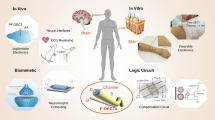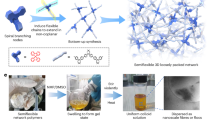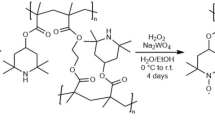Abstract
Redox-active but highly durable nitroxide radicals, that is, 2,2,6,6-tetramethylpiperidinyl-4-oxy (TEMPO), enabled direct electrospinning of radical-containing polymers without additional processing aids (such as polymer blends, post-doping, or protection/deprotection) and produced redox-active fibrous membranes with high surface area. The solution rheological behavior of the TEMPO-substituted polymethacrylate was similar to the neutral conventional polymers, and electrospinning of the radical polymers yielded submicrometer-scaled fibrous membranes without any defects on the radical moiety. The obtained membrane exhibited stable redox response, leading to redox catalysts or electrode-active materials toward organic-based flexible rechargeable battery.
Similar content being viewed by others
Log in or create a free account to read this content
Gain free access to this article, as well as selected content from this journal and more on nature.com
or
References
Hawker, C. J., Bosman, A. W. & Harth, E. New polymer synthesis by nitroxide mediated living radical polymerizations. Chem. Rev. 101, 3661–3688 (2001).
MacCorquodale, F., Crayton, J. A., Walton, J. C. & Worsfold, D. J. Synthesis and electrochemical characterisation of poly(tempoacrylate). Tetrahedron Lett. 31, 771–774 (1990).
Sheldon, R. A., Arends, I.W.C.E., Ten Brink, G- J. & Dijksman, A. Green, catalytic oxidations of alcohols. Acc. Chem. Res. 35, 774–781 (2002).
Nishide, H. & Oyaizu, K. Toward flexible batteries. Science 319, 737–738 (2008).
Nishide, H. & Suga, T. Organic radical battery. Electrochem. Soc. Interface 14, 32–38 (2005).
Nishide, H., Iwasa, S., Pu, Y.- J., Suga, T., Nakahara, K. & Satoh, M. Organic radical battery: nitroxide polymers as a cathode-active material. Electrochim. Acta. 50, 827–831 (2004).
Nakahara, K., Iwasa, S., Satoh, M., Morioka, Y., Iriyama, J., Suguro, M. & Hasegawa, E. Rechargeable batteries with organic radical cathode. Chem. Phys. Lett. 359, 351–354 (2002).
Suga, T., Sugita, S., Ohshiro, H., Oyaizu, K. & Nishide, H. p- and n-Type bipolar redox-active radical polymer: toward totally organic polymer-based rechargeable devices with variable configuration. Adv. Mater. 23, 751–754 (2011).
Suga, T., Ohshiro, H., Sugita, S., Oyaizu, K. & Nishide, H. Emerging N-type redox-active radical polymer for a totally organic polymer-based rechargeable battery. Adv. Mater. 21, 1627–1631 (2009).
Oyaizu, K., Ando, Y., Konishi, H. & Nishide, H. Nernstian adsorbate-like bulk layer of organic radical polymers for high-density charge storage purposes. J. Am. Chem. Soc. 130, 14459–14461 (2008).
Higuchi, M. Electrochromic functions of organic-metallic hybrid polymers. J. Nanosci. Nanotech. 9, 51–58 (2009).
Reneker, D. H. & Chun, I. Nanometre diameter fibres of polymer, produced by electrospinning. Nanotechnology 7, 216–223 (1996).
Greiner, A. & Wendorff, J. H. Electrospinning: a fascinating method for the preparation of ultrathin fibres. Angew. Chem. Int. Ed. 46, 5670–5703 (2007).
McKee, M. G., Layman, J. M., Cashion, M. P. & Long, T. E. Phospholipid nonwoven electrospun membranes. Science 311, 353–355 (2006).
Hunley, M. T., Mckee, M. G. & Long, T. E. Submicron functional fibrous scaffolds based on electrospun phospholipids. J. Mater. Chem. 17, 605–608 (2007).
Fukushima, S., Karube, Y. & Kawakami, H. Preparation of ultrafine uniform electrospun polyimide nanofiber. Polym. J. 42, 514–518 (2010).
Nakashima, K., Tsuboi, K., Matsumoto, H., Ishige, R., Tokita, M., Watanabe, J. & Tanioka, A. Control over internal structure of liquid crystal polymer nanofibers by electrospinning. Macromol. Rapid Commun. 31, 1641–1645 (2010).
Kim, J.- K., Cheruvally, G., Choi, J.- W., Ahn, J.- H., Choi, D. S. & Song, C. E. Rechargeable organic radical battery with electrospun, fibrous membrane-based polymer electrolyte. J. Electrochem. Soc. 154, A839–A843 (2007).
Gu, Y., Chen, D. & Jiao, X. Synthesis and electrochemical properties of nanostructured LiCoO2 fibers as cathode materials for lithium-ion batteries. J. Phys. Chem. B 109, 17901–17906 (2005).
Fan, Q. & Whittingham, M. S. Electrospun manganese oxide nanofibers as anodes for lithium-ion batteries. Electrochem. Solid-State. Lett. 10, A48–A51 (2007).
Long, Y.- Z., Li, M.- M., Gu, C., Wan, M., Duvail, J.- L., Liu, Z. & Fan, Z. Recent advances in synthesis, physical properties and applications of conducting polymer nanotubes and nanofibers. Prog. Polym. Sci. 36, 1415–1442 (2011).
Norris, I. D., Shaker, M. M., Ko, F. K. & MacDiarmid, A. G. Electrostatic fabrication of ultrafine conducting fibers: polyaniline/polyethylene oxide blends. Synth. Met. 114, 109–114 (2000).
Li, D., Babel, A., Jenekhe, S. A. & Xia, Y. Nanofibers of conjugated polymers prepared by electrospinning with a two-capillary spinneret. Adv. Mater. 16, 2062–2066 (2004).
Okuzaki, H., Takahashi, T., Miyajima, N., Suzuki, Y. & Kuwabara, T. Spontaneous formation of poly(p-phenylenevinylene) nanofiber yarns through electrospinning of a precursor. Macromolecules 39, 4276–4278 (2006).
Yonekuta, Y., Susuki, K., Oyaizu, K., Honda, K. & Nishide, H. Battery-inspired, nonvolatile, and rewritable memory architecture: a radical polymer-based organic device. J. Am. Chem. Soc. 129, 14128–14129 (2007).
Suga, T., Konishi, H. & Nishide, H. Photocrosslinked nitroxide polymer cathode-active materials for application in an organic-based paper battery. Chem. Commun. 1730–1732 (2007).
Colby, R. H., Fetters, L. J., Funk, W. G. & Graessley, W. W. Constraint release in polymer melts: tube reorganization versus tube dilation. Macromolecules 24, 3873–3882 (1991).
McKee, M. G., Wilkes, G. L., Colby, R. H. & Long, T. E. Correlations of solution rheology with electrospun fiber formation of linear and branched polyesters. Macromolecules 37, 1760–1767 (2004).
Hunley, M. T., Pötschke, P. & Long, T. E. Melt dispersion and electrospinning of non-functionalized multiwalled carbon nanotubes in thermoplastic polyurethane. Macromol. Rapid Commun. 30, 2102–2106 (2009).
Acknowledgements
This work was partially supported by Grants-in-Aid for JSPS-NSF Research Collaboration Program and Scientific Research (19105003) from MEXT, Japan. This work was also supported by the US Army Research Laboratory and the US Army Research Office under Grant Number DAAD19-02-1-0275 Macromolecular Architecture for Performance (MAP) MURI.
Author information
Authors and Affiliations
Corresponding authors
Rights and permissions
About this article
Cite this article
Suga, T., Hunley, M., Long, T. et al. Electrospinning of radical polymers: redox-active fibrous membrane formation. Polym J 44, 264–268 (2012). https://doi.org/10.1038/pj.2011.120
Received:
Revised:
Accepted:
Published:
Issue date:
DOI: https://doi.org/10.1038/pj.2011.120



